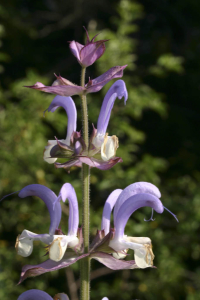Is Clary Sage Oil Estrogenic?
According to Franchomme & Pénöel (1990), clary sage oil is estrogen-like, due to its content of sclareol, which is said to be structurally similar to human estrogens. The sclareol content of clary sage oil is given as 1.6-7.0%. In gas chromatographic analyses of clary sage oil, a sclareol content of 0.1-0.4% is typical. However sclareol concentrations tend to be underestimated due to the very low volatility of the molecule, so 1.6-7.0% is probably reasonable. Clary sage absolute is a solid material, and contains about 70% sclareol, which is also solid.
Some of the more common Internet comments about the hormonal effects of clary sage oil include:
* Clary sage essential oil contains sclareol, which mimics the effects of estrogen.
* Sclareol has an estrogen-like structure, contributing to clary sage’s effectiveness in treating amenorrhea, cramps, and menstrual pain.
* Sclareol, a compound in clary sage, is not an estrogen, although it can mimic estrogen if there is an estrogen deficiency. If there is not an estrogen deficiency, sclareol will not create more estrogen in the body.
* Certain essential oils have phytoestrogenic activity. For example, sclareol, a constituent of clary sage, stimulates the body to produce its own estrogen.
* The high sclareol content gives clary sage essential oil its powerful action for relieving premenstrual tension in women as it has a balancing effect on hormones.
Note that four distinct claims are made in the above:
1) Clary sage/sclareol mimics the effects of natural estrogens.
2) Clary sage/sclareol mimics the effects of natural estrogens, but only if there is an estrogen deficiency.
3) Clary sage/sclareol stimulates the body to produce its own estrogen.
4) Clary sage/sclareol balances hormones.
Only the first of these is in line with the original statement made by Franchomme & Pénöel (1990). But is any of this supported by evidence? One of my first blogs was about parabens, and I made reference to the possibility that these chemicals might have estrogen-like effects. Many people avoid parabens for this very reason. Substances with such “hormone-disrupting” action are suspected of adversely affecting male fertility and breast cancer, among others.
So, let me pose an obvious question: if clary sage oil has an estrogen-like effect, and if you avoid parabens because you believe that they have estrogen-like effects, do you similarly avoid clary sage oil?
If you look at Dene Godfrey’s comment on The Paraben Parable you will see that butylparaben was indeed estrogen-like in an in vitro study, with an action 100,000 times weaker than estradiol. But one in vitro test tells us very little about in vivo effects. As for sclareol, I am aware of no research that has any bearing on a possible hormonal action. [Clary sage oil is sometimes contraindicated in pregnancy, though there is no supporting evidence for this. It was used in two childbirth studies in the UK, with no apparent adverse effects (Burns et al 2000, 2007)].
Both estradiol and butylparaben contain a phenol functional group: a hydroxyl group (OH) attached to a benzene ring. The phenolic structure is important for estrogenicity, as is the presence of a second ring (Anstead et al 1997, Blair et al 2000). However, sclareol does not contain a phenolic structure, it doesn’t even contain a benzene ring. Sclareol is a labdane diterpene, and this class of molecule does not incorporate estrogen-like structures, nor is it noted for estrogenic activity (Topçu and Gören 2007).
 Therefore, on the basis of its structure, sclareol is unlikely to have any estrogenic action. Even if sclareol was estrogenic, at about 4% of clary sage oil, it would have to have a very high binding affinity for estrogen receptor sites for the essential oil to have any effect, and this is extremely unlikely.
Therefore, on the basis of its structure, sclareol is unlikely to have any estrogenic action. Even if sclareol was estrogenic, at about 4% of clary sage oil, it would have to have a very high binding affinity for estrogen receptor sites for the essential oil to have any effect, and this is extremely unlikely.This does not mean that clary sage oil is not effective. It may well be useful in relieving menstrual pain, pre-menstrual symptoms, menopausal symptoms and other problems, but none of this necessitates an estrogen-like action. And, I’m not saying that sclareol could not possibly be estrogen-like, I’m just saying there’s no evidence that it is, nor does its structure suggest such an effect. This also means that there’s no evidence to support clary sage oil “balancing hormones”, mimicking estrogens only if there is an estrogen deficiency, or stimulating the body to produce natural estrogens.
Sclareol does have an interesting anticancer activity, including in vitro action against human breast cancer MCF-7 cells (Dimas et al 2006). An isomer, 13-epi-sclareol, which is also present in clary sage oil, inhibits the growth of breast and uterine cancers in vitro, and was slightly more potent than Tamoxifen, but was not toxic to normal cells (Sashidhara et al 2007). This suggests the possibility that sclareol might actually inhibit estrogen, and might after all have some capacity to interact with estrogen receptor sites. What we do know is that sclareol will not give you breast cancer.
Thanks to Sherrie Bitts for raising the question of sclareol safety on the Aromatherapy Thymes blog, and to Lora Cantele for suggesting this to me as a subject.
References:
Anstead GM, Carlson KE, Katzenellenbogen JA 1997 The estradiol pharmacophore: ligand structure-estrogen receptor binding affinity relationships and a model for the receptor binding site.
Blair RM, Fang H, Branham WS et al 2000 The estrogen receptor relative binding affinities of 188 natural and xenochemicals: structural diversity of ligands. Toxicological Sciences 54:138-153
Burns E E, Blamey C, Ersser S J et al 2000 An investigation into the use of aromatherapy in intrapartum midwifery practice. Journal of Alternative & Complementary Medicine 6:141-147
Burns E, Zobbi V, Panzeri D et al 2007 Aromatherapy in childbirth: a pilot randomised controlled trial. BJOG 114:838-844
Dimas K, Papadaki M, Tsimplouli C et al 2006 Labd-14-ene-8,13-diol (sclareol) induces cell cycle arrest and apoptosis in human breast cancer cells and enhances the activity of anticancer drugs. Biomedicine & Pharmacotherapy 60:127-133
Franchomme P, Pénöel D 1990 L’aromathérapie exactement. Jollois, Limoges
Sashidhara KV, Rosaiah JN, Kumar A 2007 Cell growth inhibitory action of an unusual labdane diterpene, 13-epi-sclareol in breast and uterine cancers in vitro. Phytotherapy Research 21:1105-1108
Topçu G, Gören AC 2007 Biological activity of diterpenoids isolated from Anatolian Lamiaceae plants. Records of Natural Products 1:1-16



No comments:
Post a Comment